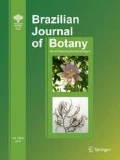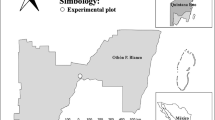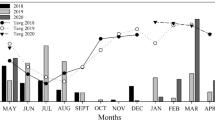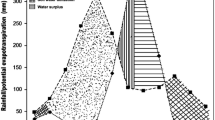Abstract
Investigations on the propagation and establishment of native grasses of rupestrian grassland on degraded substrates are essential to enable their use in the restoration of degraded areas, thus reducing the use of exotic species. This study aimed to evaluate the sexual and asexual propagation, establishment and growth of Axonopus laxiflorus (Trin.) Chase and Sporobolus metallicolus Longhi-Wagner & Boechat, two native grasses from rupestrian grassland developed on laterite substrate of an area degraded by bauxite mining. In greenhouse experiments, A. laxiflorus was propagated by tillers and S. metallicolus by seeds and tillers. Both species were also evaluated for germination in a germination chamber on the treatments: control, addition of potassium nitrate and heating at 80 °C for 2 min. In these evaluations, success of S. metallicolus germination was between 77 and 90%, without significative difference among treatments, whereas A. laxiflorus did not germinate. In the laterite substrate, S. metallicolous, propagated by seeds, showed 29% of survival, whereas in the vegetative propagation all plants of the two species survived. Eight months after starting the tiller experiment, S. metallicolus and A. laxiflorus presented a biomass increase of 239 and 75%, respectively. Although A. laxiflorus showed root biomass approximately seven times higher than S. metallicolus, the two species presented similar root length, that is, S. metallicolus contained more fine roots. The results show that the species can efficiently propagate vegetatively and, in the case of S. metallicolus, sexually. The success of the species in a substrate poor in nutrients and rich in Al, Fe and Mn indicates that they can be used in the restoration of areas degraded by bauxite and iron mining, which are important mining activities in Brazil.
Similar content being viewed by others
Change history
14 June 2018
The layout of Table 1 was incorrect in the PDF version of the initial online publication. The original article has been corrected.
References
Aires SS, Sato MN, Miranda HS (2013) Seed characterization and direct sowing of native grass species as a management tool. Grass Forage Sci 69:470–478. https://doi.org/10.1111/gfs.12077
Alvares CA, Stape JL, Sentelhas PC, Gonçalves JLM, Sparovek G (2014) Koppen’s climate classification map for Brazil. Meteorol Z 22:711–728. https://doi.org/10.1127/0941-2948/2013/0507
Barbosa NPU, Fernandes GW, Carneiro MAA, Júnior LAC (2010) Distribution of non-native invasive species and soil properties in proximity to paved roads and unpaved roads in a quartzitic mountainous grassland of southeastern Brazil (rupestrian fields). Biol Invasions 12:3745–3755. https://doi.org/10.1007/s10530-010-9767-y
Beckman NG, Muller-Landau HC (2011) Linking fruit traits to variation in predispersal vertebrate seed predation, insect seed predation, and pathogen attack. Ecology 92:2131–2140. https://doi.org/10.1890/10-2378.1
Benites VM, Schaefer CEGR, Simas FNB, Santos HG (2007) Soils associated with rock outcrops in the Brazilian mountain ranges Mantiqueira and Espinhaço. Braz J Bot 30:569–577. https://doi.org/10.1590/S0100-84042007000400003
Bradshaw A (1997) Restoration of mined lands-using natural processes. Ecol Eng 8:255–269. https://doi.org/10.1016/S0925-8574(97)00022-0
BRASIL-Ministério da AgriculturaPecuária e Abastecimento (2009) Regras para análise de sementes. MAPA/ACS, Brasília
Bucharova A, Michalski S, Hermann JM, Heveling K, Durka W, Hölzel N, Kollmann J, Bossdorf O (2017) Genetic differentiation and regional adaptation among seed origins used for grassland restoration: lessons from a multispecies transplant experiment. J Appl Ecol 54:127–136. https://doi.org/10.1111/1365-2664.12645
Burylo M, Rey F, Mathys N, Dutoit T (2012) Plant root traits affecting the resistance of soils to concentrated flow erosion. Earth Surf Processes 37:1463–1470. https://doi.org/10.1002/esp.3248
Carmo FF, Campos IC, Jacobi CM (2016) Effects of fine-scale surface heterogeneity on rock outcrop plant community structure. J Veg Sci 27:50–59. https://doi.org/10.1111/jvs.12342
Carmona R, Camilo MGB, Martins CR (1997) Estímulo à germinação em sementes de Gymnopon doellii—uma gramínea ameaçada de extinção. Rev Bras Fisiol Veg 9:125–130
Carmona R, Martins CR, Favero AP (1998) Fatores que afetam a germinação de sementes de gramíneas nativas do cerrado. Rev Bras Sementes 20:16–22. https://doi.org/10.17801/0101-3122/rbs.v20n1p16-22
Carmona R, Martins CR, Favero AP (1999) Características de sementes de gramíneas nativas do cerrado. Pesqu Agropec Bras 34:1067–1074. https://doi.org/10.1590/S0100-204X1999000600019
Carvalho F, Godoy EL, Lisboa FJG, Moreira FMS, Souza FA, Berbara LL, Fernandes GW (2014) Relationship between physical and chemical soil attributes and plant species diversity in tropical mountain ecosystems from Brazil. J Mt Sci 11:875–883. https://doi.org/10.1007/s11629-013-2792-4
Castro MFM, Lima HM, Flôres JCC (2011) Overview of mine closure in Minas Gerais, Brazil. Rev Esc Minas 64:205–211
César RG, Viani RAG, Silva MCS, Brancalion PHS (2014) Does a native grass (Imperata brasiliensis Trin.) limit tropical forest restoration like an alien grass (Melinis minutiflora P. Beauv.)? Trop Conserv Sci 7:639–656. https://doi.org/10.1177/194008291400700405
Coelho FF, Capelo C, Figueira JEC (2008) Seedlings and ramets recruitment in two rhizomatous species of Rupestrian grasslands: Leiothrix curvifolia var. lanuginosa and Leiothrix crassifolia (Eriocaulaceae). Flora 203:153–161. https://doi.org/10.1016/j.flora.2007.02.005
COPAM—Conselho Estadual de Política Ambiental (2008) Deliberação no 367: aprova a lista das espécies ameaçadas de extinção da flora do Estado de Minas Gerais. http://www.siam.mg.gov.br/sla/download.pdf?idNorma=9450. Acessed 25 Mar 2017
Craw D, Rufalt CG, Hammit S, Clearwater SG, Smith CM (2007) Geological controls on natural ecosystem recovery on mine waste in southern New Zealand. Environ Geol 51:1389–1400. https://doi.org/10.1007/s00254-006-0436-5
Fernandes GW, Barbosa NPU (2013) Bombas relógio que ameaçam a natureza em Minas Gerais. Sci Am Braz 135:60–61
Fernandes GW, Barbosa NPU, Negreiros D, Paglia AP (2014) Challenges for the conservation of vanishing megadiverse rupestrian grasslands. Nat Cons 12:162–165. https://doi.org/10.1016/j.ncon.2014.08.003
Fernandes GW, Santos R, Barbosa NPU, Almeida HA, Carvalho V, Angrisano P (2015) Ocorrência de plantas não nativas e exóticas em áreas restauradas de campos rupestres. Planta Daninha 33:463–482. https://doi.org/10.1590/S0100-83582015000300009
Fernandes GW, Toma TSP, Angrisano P, Overbeck G (2016) Challenges in the restoration of quartzitic and ironstone rupestrian grasslands. In: Fernandes GW (ed) Ecology and conservation of mountaintop grasslands in Brazil. Springer, Berlin, pp 449–477
Figueiredo MA, Baêta HE, Kozovits AR (2012) Germination of native grasses with potential application in the recovery of degraded areas in Quadrilátero Ferrífero, Brasil. Biota Neotrop 12:118–123. https://doi.org/10.1590/S1676-06032012000300013
Figueiredo MA, Leite MGP, Kozovits AR (2015) Influence of soil texture on nutrients and potentially hazardous elements in Eremanthus erythropappus. Int J Phytoremediat 18:487–493. https://doi.org/10.1080/15226514.2015.1115961
Fontaneli RS, Fontaneli RS, Santos HP, Mariani F, Pivotto AC, Signor LR, Zanella D (2009) Gramíneas forrageiras perenes de verão. Forrageiras para integração lavoura-pecuária-floresta na região sul-brasileira, 2ed. Embrapa, Brasília, pp 247–295
Griffiith JJ, Toy TJ (2001) La revegetación de las minas de hierro en el estado de Minas Gerais, Brasil. Unasylva 52:9–30
Haridasan M (2008) Nutritional adaptations of native plants of the cerrado biome in acid soils. Braz J Plant Physiol 20:183–195. https://doi.org/10.1590/S1677-04202008000300003
Hugles AR, Inouye BD, Jonhnson MTJ, Underwood N, Vellend M (2008) Ecological consequences of genetic diversity. Ecol Lett 11:609–623. https://doi.org/10.1111/j.1461-0248.2008.01179.x
IBAMA (2011) Instruçao Normativa IBAMA No 04, DE 13-04-2011
Jacobi CM, Carmo FF (2012) Diversidade florística nas cangas do Quadrilátero Ferrífero. IDM, Belo Horizonte
Jacobi CM, Carmo FF, Vincent RC, Stehmann JR (2007) Plant communities on ironstone outcrops: a diverse and endangered Brazilian ecosystem. Biodivers Conserv 16:2185–2200
Jacobi CM, Carmo FF, Vincent RC (2008) Estudo fitossociológico de uma comunidade vegetal sobre canga como subsídio para a reabilitação de área mineradas no Quadrilátero Ferrífero. MG. Rev. Árvore 32:345–353. https://doi.org/10.1590/S0100-67622008000200017
Kabata-Pendias A (2011) Trace elements in soils and plants, 4th edn. Taylor and Francis, London
Kolb RM, Pilon NAL, Durigan G (2016) Factors influencing seed germination in Cerrado grasses. Acta Bot Bras 30:87–92. https://doi.org/10.1590/0102-33062015abb0199
Le Stradic S, Buisson E, Fernandes GW (2014) Restoration of Neotropical grasslands degraded by quarrying using hay transfer. Appl Veg Sci 17:482–492
Le Stradic S, Silveira FAO, Buisson E, Cazelles K, Carvalho V, Fernandes W (2015) Diversity of germination strategies and seed dormancy in herbaceous species of campo rupestre grasslands. Aust Ecol 40:537–546. https://doi.org/10.1111/aec.12221
Leite RR, Araujo SSC, Oliveira EG (2013) Remoção dos frutos de Miconia albicans (sw.) triana (Melastomataceae) por formigas na borda e no interior de um fragmento de Cerrado, Curvelo. MG. Rev Árvore 37:469–478. https://doi.org/10.1590/S0100-67622013000300010
Levine JM, Vilà M, D’Antônio CM, Dukes JS, Grigulis K, Lavorel S (2003) Mechanisms underlying the impacts of exotic plant invasions. P R Soc Lond 270:775–781. https://doi.org/10.1098/rspb.2003.2327
Lima YBC, Durigan G, Souza FM (2014) Germination of 15 Cerrado plant species under different light conditions. Biosci J 30:1864–1872
Lima CT, Furtini Neto AE, Giulietti AM, Mota NF de O, Braga R de P, Viana PL (2016) Guia de plantas para a recuperação de áreas degradadas nas cangas do Quadrilátero Ferrífero de Minas Gerais. Fundação Brasil Cidadão, Fortaleza
Machado NADM, Leite MGP, Figueiredo MA, Kozovits AR (2013) Growing Eremanthus erythropappus in crushed laterite: a promising alternative to topsoil for bauxite-mine revegetation. J Environ Manag 129:149–156. https://doi.org/10.1016/j.jenvman.2013.07.006
Marques TED, Baêta HE, Leite MGP, Martins SV, Kozovits AR (2014) Crescimento de espécies nativas de cerrado e de Vetiveria zizanioides em processos de revegetação de voçorocas. Ciênc Florest 24:843–856
McKay JK, Christian CE, Rice Harrison S, Rice KJ (2005) “How local is local?”—a review of practical and conceptual issues in the genetics of restoration. Restor Ecol 13:432–440. https://doi.org/10.1111/j.1526-100X.2005.00058
Messias MCTB, Leite MGP, Meira-Neto JAA, Kozovits AR (2011) Life-form spectra of quartzite and itabirite rocky outcrop sites, Minas Gerais, Brazil. Biota Neotrop 11:255–268. https://doi.org/10.1590/S1676-06032011000200026
Messias MCTB, Leite MGP, Meira-Neto JAA, Kozovits AR (2012) Fitossociologia de campos rupestres quartzíticos e ferruginosos no Quadrilátero Ferrífero, Minas Gerais. Acta Bot Bras 26:230–242. https://doi.org/10.1590/S0102-33062012000100022
Messias MCTB, Leite MGP, Meira-Neto JAA, Kozovits AR, Tavares R (2013) Soil-vegetation relationship in quartzitic and ferruginous brazilian rocky outcrops. Folia Geobot 48:509–521. https://doi.org/10.1007/s12224-013-9154-4
Mourão A, Stehmann JR (2007) Levantamento da flora do campo rupestre sobre canga hematítica couraçada remanescente na mina do Brucutu, Barão de Cocais, Minas Gerais, Brasil. Rodriguésia 58:775–786
Neves ACO, Barbieri AF, Pacheco AA, Resende FM, Braga RF, Azevedo AA, Fernandes GW (2016) The human dimension in the Espinhaço Mountains: Llnd conversion and ecosystem services. In: Fernandes GW (ed) Ecology and conservation of mountaintop grasslands in Brazil. Springer, Berlin, pp 501–530
Nunes FP, Dayrell RLC, Silveira FAO, Negreiros D, Santana DG, Carvalho FJ, Garcia QS, Fernandes GW (2016) Seed Germination Ecology in Rupestrian Grasslands. In: Fernandes GW (ed) Ecology and conservation of mountaintop grasslands in Brazil. Springer, Berlin, pp 207–225
Perez NB (2008) Multiplicação Vegetativa de Plantas Forrageiras—recomendações para plantio. Embrapa Pecuária Sul, Bagé
Ranal M, de Santana DG (2006) How and why to measure the germination process? Braz J Bot 29:01–11. https://doi.org/10.1590/S0100-84042006000100002
Rede Sementes do Xingu (2016) Informativo sobre a Rede de Sementes do Xingu. http://sementesdoxingu.org.br/site/wpcontent/uploads/2016/07/boletim-rede-2016-site.pdf. Accessed 25 Mar 2017
Rogers D, McGuire P (2015) Genetic erosion: Context is key. In: Ahuja M, Jain S (eds) Genetic diversity and erosion in plants. Sustainable development and biodiversity. Springer, Berlin, pp 01–24
Rossi RD, Martins CR, Viana PL, Rodrigues EL, Figueira JEC (2014) Impact of invasion by molasses grass (Melinis minutiflora P. Beauv.) on native species and on fires in areas of campo-cerrado in Brazil. Acta Bot Bras 28:631–637. https://doi.org/10.1590/0102-33062014abb3390
Salomão NA, Silva JCS (2003) Germinação análise e armazenamento de sementes. In: Salomão NA (ed) Germinação de sementes e produção de mudas de plantas do cerrado. Rede de Sementes do Cerrado, Brasília, pp 3–8
Schettini AT, Leite MGP, Messias MCTB, Gauthier A, Li H, Kozovits AR (2017) Exploring Al, Mn and Fe phytoextraction in 27 rocky outcrops plant species. Flora. https://doi.org/10.1016/j.flora.2017.05.00
Shanker AK, Cervantes C, Loza-Tavera H, Avudainayagam S (2005) Chromium toxicity in plants. Environ Int 31:739–753. https://doi.org/10.1016/j.envint.2005.02.003
Silva JSO, Haridasan M (2007) Acúmulo de biomassa aérea e concentração de nutrientes em Melinis minutiflora P. Beauv. e gramíneas nativas do cerrado. Braz J Bot 30:337–344. https://doi.org/10.1590/S0100-84042007000200016
Silveira FAO, Negreiros D, Barbosa NPU et al (2015) Ecology and evolution of plant diversity in the endangered campo rupestre: a neglected conservation priority. Plant Soil 403:129–152. https://doi.org/10.1007/s11104-015-2637-8
Silvério DV, Brando PM, Balch JK, Putz FE, Nepstad DC, Oliveira-Santos C, Bustamante MMC (2013) Testing the Amazon savannization hypothesis: fire effects on invasion of a neotropical forest by native cerrado and exotic pasture grasses. Philos T R Soc B 368:20120427. https://doi.org/10.1098/rstb.2012.0427
Sommerville K, Rosseto M, Pulkownik A (2013) Maximising adaptive potential in translocated populations of clonal saltmarsh plants: a case study on Wilsonia backhousei, Convolvulaceae. Wetlands Ecol Manag 21:339–351
Teixeira WA, Lemos Filho JP (1998) Metais pesados em folhas de espécies lenhosas colonizadoras de uma área de mineração de ferro em Itabirito, Minas Gerais. Rev Árvore 22:381–388
Valim EAR, Nalini HA Jr, Kozovits AR (2013) Litterfall dynamics in a iron-rich rock outcrop complex in the southeastern portion of the Iron Quadrangle of Brazil. Acta Bot Bras 27:286–293. https://doi.org/10.1590/S0102-33062013000200005
Veldman JW, Buisson E, Durigan G et al (2015) Toward an old-growth concept for grasslands, savannas, and woodlands. Front Ecol Environ 13:154–162. https://doi.org/10.1890/140270
Vellend M (2006) The consequence of genetic diversity in competitive Comunities. Ecology 87:304–311. https://doi.org/10.1890/05-0173
Viana PL, Lombardi JA (2006) Florística e caracterização dos campos rupestres sobre canga na serra da Calçada, Minas Gerais, Brasil. Rodriguésia 58:159–177
Vincent RC, Meguro M (2008) Influence of soil properties on the abundance of plant species in ferruginous rocky soils vegetation, southeastern Brazil. Braz J Bot 31:377–388. https://doi.org/10.1590/S0100-84042008000300002
Wang X, Liu Y, Zeng G, Chai L, Xiao X, Song X, Min Z (2008) Pedological characteristics of Mn mine tailings and metal accumulation by native plants. Chemosphere 72:1260–1266. https://doi.org/10.1016/j.chemosphere.2008.05.001
Wentworth CK (2011) A scale of grade and class terms for clastic sediments. Geol Surv 30:377–392
Williams SL, Davis CA (1996) Populations genetic analyses of transplanted eelgrass (zostera marina) beds reveal reduced genetic diversity in southern California. Restor Ecol 4:163–180. https://doi.org/10.1111/j.1526-100X.1996.tb00117.x
Willians SL (2001) Reduced genetic diversity in eelgrass transplantations affects both population growth and individual fitness. Ecol Appl 11:1472–1488. https://doi.org/10.1890/1051-0761(2001)
Yang L, Ren H, Liu N, Wang J (2013) Can perennial dominant grass Miscanthus sinensis be nurse plant in recovery of degraded hilly land landscape in South China? Landascape Ecol Eng 9:213–225. https://doi.org/10.1007/s11355-012-0199-y
Acknowledgements
We would like to thank Prof. José Badini Herbarium, the Jorge Luiz da Silva Botanical Garden, the laboratories of Plant Ecophysiology, Biodiversity and Plant Anatomy (DEBIO), and the Laboratory of Geochemistry (DEGEO) of the Federal University of Ouro Preto for the provision of infrastructure and assistance in the development of this study. We thank Gerhard Overbeck, Fernando Silveira and anonymous reviewer for the constructive comments on this manuscript. This study was supported by Federal University of Ouro Preto.
Author information
Authors and Affiliations
Corresponding author
Additional information
The original article has been revised: the layout of Table 1 has been corrected.
Rights and permissions
About this article
Cite this article
Figueiredo, M.A., Diniz, A.P., Messias, M.C.T.B. et al. Propagation and establishment of rupestrian grassland grasses for restoration of degraded areas by mining. Braz. J. Bot 41, 287–295 (2018). https://doi.org/10.1007/s40415-018-0456-x
Received:
Accepted:
Published:
Issue Date:
DOI: https://doi.org/10.1007/s40415-018-0456-x




